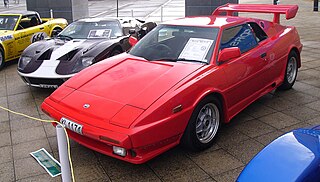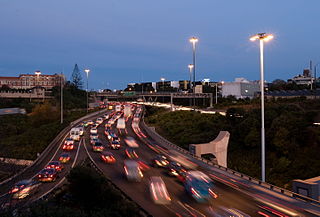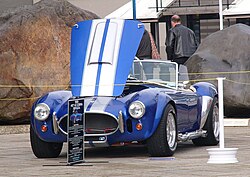
A Locost is a home-built car inspired by the Lotus Seven. The car features a space frame chassis usually welded together from mild steel 1 in × 1 in square tubing. Front suspension is usually double wishbone with coil spring struts. The rear is traditionally live axle, but has many variants including independent rear suspension or De Dion tube. Body panels are usually fiberglass nose and wings and aluminium side panels. Each car is highly individualized according to the resources, needs and desires of each respective builder.

The Lotus Seven is a small, simple, lightweight two-seater open-top sports car produced by the British manufacturer Lotus Cars between 1957 and 1972.

A kit car is an automobile available as a set of parts that a manufacturer sells and the buyer then assembles into a functioning car. Usually, many of the major mechanical systems such as the engine and transmission are sourced from donor vehicles or purchased new from other vendors. Kits vary in completeness, consisting of as little as a book of plans, or as much as a complete set with all components to assemble into a fully operational vehicle such as those from Caterham.

AC Cars, originally incorporated as Auto Carriers Ltd., is a British specialist automobile manufacturer and one of the oldest independent car makers founded in Britain. As a result of bad financial conditions over the years, the company was renamed or liquidated many times until its present form.

The AC Cobra, sold in the United States as the Shelby Cobra and AC Shelby Cobra, is a sports car manufactured by British company AC Cars, with a Ford V8 engine. It was produced intermittently in both the UK and later the USA since 1962.

The Shelby Daytona Coupe is an American sports-coupé. It is related to the Shelby Cobra roadster, loosely based on its chassis and drive-train developed and built as an advanced evolution. It was engineered and purpose built for auto racing, specifically to take on Ferrari and its 250 GTO in the GT class. The original project had six Shelby Daytona Coupes built for racing purposes between 1964 and 1965, as Carroll Shelby was reassigned to the Ford GT40 project to compete at the 24 Hours of Le Mans, again to beat Ferrari in the highest level prototype class. With the Shelby Daytona, Shelby became the first American constructor to win a title on the international scene in the FIA International Championship for GT Manufacturers in 1965. The Shelby Daytona has recently been chosen for historic preservation as a significant vehicle in the history of auto racing.

Locust is a kit car inspired by the Lotus Seven. It was first developed in the mid 1980s as a cheap kit car to be built onto the chassis of a Triumph Spitfire, it was later developed into a full kit car which used its own fully designed ladder chassis - unlike others using space frame. The car was famed for its cheap to build construction using MDF in the body, the last kits were produced in early 2000.

Shelby American, Inc. is an American high performance vehicle manufacturer founded by former race car driver Carroll Shelby. The Shelby American name has been used by several legally distinct corporations founded by Shelby since his original shop in Venice, California began operation in 1962. The current iteration is a wholly owned subsidiary of Carroll Shelby International, Inc., a holding company formed in 2003. Carroll Shelby International's other wholly owned subsidiary is Carroll Shelby Licensing, which licenses the name and trademarks associated with Shelby to other companies. Shelby American was the first automobile manufacturer in the state of Nevada. Shelby American manufactures component automobiles, including replicas of the small-block and large-block AC Cobras, the Shelby GT350 and the GT500 Super Snake. Since 2005, Shelby American has released new models each year.
Fiberfab was an American automotive manufacturer established in 1964. Starting with accessories and body parts, they progressed to making kit cars and fully assembled automobiles. They became one of the longest lasting kit car manufacturers.

The Bill Thomas Cheetah was an American sports car designed and engineered entirely with American components, and built from 1963 to 1966 by Chevrolet performance tuner Bill Thomas. It was developed as a competitor to Carroll Shelby's Cobra.

The Purvis Eureka is a sports car which was produced by Purvis Cars at Dandenong in Victoria, Australia from 1974 to 1991.
The Blakely Bantam was a kit car produced by Blakely Auto Works, a manufacturer of kit cars located in a series of US midwest communities in the 1970s and 1980s. Blakely Auto was founded by Dick Blakely to market affordable sports cars in the spirit of the legendary Lotus Seven: compact, lightweight, and with excellent handling. The Bantam's design inspiration was the Dutton, a Lotus Seven replica built in Britain. The Bantam was introduced in 1972 as Blakely's first offering, followed by the larger Bearcat and eventually by the Bernardi. Production of the Bantam continued into the 1980s, when the model was renamed the Hawk, and stopped with the dissolution of Bernardi Auto Works in the later 1980s.
Dax Cars is a British sports car manufacturer founded in 1968 and based in North Weald, Essex, England.
Chevron Engineering Specialties Ltd is a New Zealand based kit-car and race-car manufacturer owned by Evan and Barbara Fray and founded in 1980. It is based in Massey, Auckland and manufactures three different models, with the Aprisa and Cypher competing in New Zealand sports car racing.

Heron Cars were racing cars, sports and kit cars built in New Zealand between 1962 and 1999 by Ross Baker. They also included a one-off electric car.
Microplas Limited was formed in 1954 in Uxbridge by group of 750 Motor Club members. They were Mike Eyre, Roger Everett, Bill Ashton, Sandy Wemyss, Tony Wemyss, and one other who was associated with the Hunting family. The Huntings were among the first to make reinforced plastics for the British military during World War Two. Microplas had access to this technology. The Mircroplas also traded as Microbond.

Alternative Cars Limited is a New Zealand-based kit car company that manufactures fiber-glass bodied cars based on the 1950s MG TF. The company was founded by Russell Hooper, a medical supply representative, as Kit Kars Limited in 1984. In 1996 Kit Kars Ltd changed its name to Alternative Cars Limited. Initially the company operated from the owner's home, until moving to a small 600 square foot workshop in Auckland.

The automotive industry in New Zealand supplies a market which has always had one of the world's highest car ownership ratios. The distributors of new cars are essentially the former owners of the assembly businesses. At the dealership level they have maintained their old retail chains in spite of the establishment of the many new independent businesses built since the 1980s by specialists in used imports from Japan. Toyota entered into direct competition with those used-import businesses refurbishing old Toyotas from Japan and selling them through their own dealers as a special line. The nation's car fleet is accordingly somewhat older than in most developed countries.

New Zealand had a long history of small garages and vehicle enthusiasts modifying and creating sports and sports racing cars. Out of these interests grew the New Zealand kit and replica car industry with the introduction of fibre-glass car bodies in the 1950s.

RW Kit Cars Ltd. was an English manufacturer of kit cars, founded in 1983 by Roger Woolley.
















